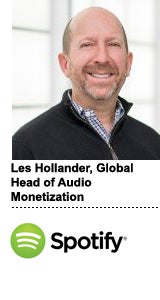 Spotify revealed Thursday that Katz Radio Group will serve as its exclusive representative for geotargeted audio sales in the United States.
Spotify revealed Thursday that Katz Radio Group will serve as its exclusive representative for geotargeted audio sales in the United States.
The radio representation company’s digital division, Katz Digital, will oversee Spotify’s DMA-targeted audio solutions, freeing up the streaming service to focus on broader brand offerings across the platform.
Spotify had already been active in selling ads targeted using DMA and Metro Survey Areas (or MSA, the term used by Nielsen for broadcast radio), but it has seen increasing demand beyond what its in-house team prefers to handle.
“We are getting growing in-bound demand for geotargeted audio inventory from large, mid-sized and smaller agencies across the country,” said Les Hollander, global head of audio monetization at Spotify.
These range from long-tail inventory in a single market to national spot radio in which large holding companies buy 50 DMAs at a time for major brands. By outsourcing its geotargeting to Katz, Spotify is looking to let a specialist take over, allowing the streaming service to focus on serving large holding companies and big brands.
“Working on a 10-, 20-, 30-market buy for audio is probably two or three times more time-consuming than doing a cross-platform brand solution for a single brand,” said Hollander. “It’s a time-consuming part of our business, very labor intensive, so we are using some efficiencies in our resources by giving this off to Katz. They are an expert in this field.”
Geotargeted ads remain a small part of Spotify’s business (though Hollander could not provide an exact percentage). But he emphasized that advertisers who buy geotargeted campaigns “tend to use that data to drive higher CPMs, and are willing to pay higher CPMs based on that granular targeting,” which drives up its value for Spotify.
The streaming company, which draws in 44 million unique monthly users per comScorce, also incorporates this geotargeting into its growing video advertising, launched last year. Spotify uses Salesforce as its CRM tool and makes Mediaocean’s end-to-end software solution available for buyers to see the Triton ratings in local markets.
The selection of Katz was a natural choice. Spotify’s global head of ad sales, Brian Benedik, previously ran Katz, and Hollander had been a Katz client during his time in the broadcast business. Hollander pointed out that the representation company already has more than 100 salespeople nationally who are already representing large broadcasters and pure plays for streaming inventory.
“There was a conversation that happened for a period of about four months and then we were able to come to an agreement that made sense for everybody,” said Hollander.
He described the partnership as the move of a growing company in an evolving sector of the ad world. Hollander pointed to the speech at Advertising Week from Spotify founder Daniel Ek about “a renaissance of sound in advertising,” referring to how the growing traffic on mobile in streaming radio has made audio and sound an increasingly important ad product.
“Not only broadcast audio buyers, but digital buyers have come to realize that by using audio in a media campaign, they are driving higher campaign metrics than just using display,” said Hollander. “When you look at that ad stack for mobile and what are the effective ad products, certainly audio is in that top three.”











